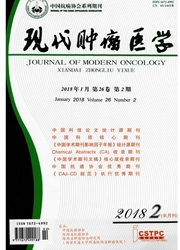

 中文摘要:
中文摘要:
目的:研究体内S100A6基因过表达对肺腺癌移植瘤生长的影响及其可能机制。方法:18只健康Balb/c雄性裸鼠随机分为三组,空载体对照组、阴性对照组及S100A6基因过表达组,每组6只;分别应用含有空载质粒、未转染任何质粒以及过表达S100A6基因的A549肺腺癌细胞接种于裸鼠皮下,构建肺腺癌移植瘤动物模型;观察不同组移植瘤组织体积、质量及微观形态学,检测S100A6基因的表达和细胞凋亡。结果:成功构建了S100A6基因过表达肺腺癌移植瘤动物模型;S100A6过表达组肿瘤组织的体积和质量均明显高于阴性对照组和空载体对照组;S100A6基因过表达组肿瘤细胞体积较大,核异型性明显;核浆比例大,核糖体和粗面内质网较多,肺泡隔小血管内可见癌栓;S100A6基因或蛋白表达在三组之间差异具有统计学意义(P〈0.05);S100A6基因过表达组肿瘤凋亡细胞数显著低于阴性对照组和空载体对照组(P〈0.05)。结论:肺腺癌细胞S100A6基因过表达可显著促进在体肺腺癌细胞的生长,其可能涉及了细胞凋亡途径,为探索肺癌发病机制提供了实验基础。
 英文摘要:
英文摘要:
Objective: To explore the influence of S100A6 gene overexpression on growth and apoptosis of transplanted lung adenocarcinoma in nude rats and its possible mechanism. Methods: 18 healthy male Balb / c nude mice were randomly divided into three groups,empty vector control group( 6 cases),negative control group( 6 cases) and S100A6 gene overexpression group( 6 cases). The transplanted lung adenocarcinoma models were established by subcutaneous injection of A549 lung adenocarcinoma cells line with empty vector,non- carrier vector and p Len O- DCE- S100A6,respectively. The volume,mass and pathology of transplanted tumor in different groups were observed. The S100A6 expression and cell apoptosis were detected by molecular biology methods. Results: The transplanted lung adenocarcinoma with S100A6 overexpression gene in nude mices was successfully established. The tumor volume and mass of S100A6 overexpression group were significantly higher than that of empty vector control group and negative control group( P 0. 05). Pathological feature in the S100A6 overexpression group were that cells size became larger,nuclear pleomorphism was obvious and nucleocytoplasmic ratio was larger. There were more ribosome and rough endoplasmic reticulum in cytoplasm and some cancer thrombus appeared in the small blood vessels of alveolar septum. The expression of S100A6 among the three groups had significant difference( P 0. 05). Tumor cell apoptosis in S100A6 overexpression group were significantly higher than that in empty vector control group and negative control group( P 0. 05). Conclusion: The overexpression of S100A6 could significantly facilitate tumor cell growth via apoptosis pathway,which established experiment basis for explore molecular mechanism of lung cancer.
 同期刊论文项目
同期刊论文项目
 同项目期刊论文
同项目期刊论文
 期刊信息
期刊信息
